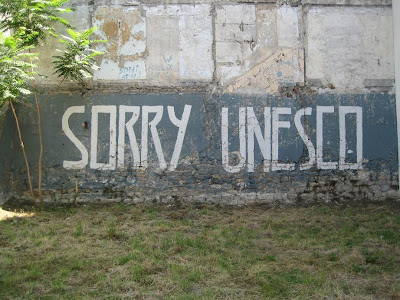 On the corner of the Rue de Belleville and the Avenue Simon Bolivar is perhaps the best example of a ghost sign in Paris today. Ghost signs are the traces of hand-painted wall adverts which are fairly common in rural France but comparatively rare in Paris, but this one for the St Raphael quinquina drink is an excellent model.
On the corner of the Rue de Belleville and the Avenue Simon Bolivar is perhaps the best example of a ghost sign in Paris today. Ghost signs are the traces of hand-painted wall adverts which are fairly common in rural France but comparatively rare in Paris, but this one for the St Raphael quinquina drink is an excellent model.Saint Raphael was one of the most popular apéritif drinks in France a generation or so ago, but is very difficult to find today (although you can still buy it here). It is a kind bitter vermouths based on partially fermented grape juice (mistelles) and quinine, with orange, vanilla, cocoa and aromatic plants. It was invented in 1830 by a certain Docteur Juppet, with, as usual, proclaimed medicinal properties!
As this website shows, it was a brand that often used this kind of wall advertising. This site also explains why this sign in Paris must have dated from before 1940. By briefly reading up on the evolution of laws relating to alcoholic drinks, we can probably conclude that the sign here was added after the 1920s.
 The sign here is also signed Affiches F.Hamet, not the artist, but surely the purchaser of the space - a kind of JC Decaux of the epoque!
The sign here is also signed Affiches F.Hamet, not the artist, but surely the purchaser of the space - a kind of JC Decaux of the epoque!
In the UK, Sam Roberts is the co-ordinator of a huge project - http://www.ghostsigns.co.uk/ - seeking to document such adverts across the country. Nothing similar seems to exist in France, but the website does give a lot of details on the history of this style of advertising. What is perhaps missing though, and the question I ask myself when looking at this advert, is how long were such adverts supposed to last for? Were the owners of the building paid a certain amount of money for a certain period of time?
What is clear though is why there are so few examples in Paris. Hand painted adverts need brick to survive! Paris, with its the neat stone facades, limited blank wall space and the obligatory sandblasting of buildings could not expect to keep many traces. So this one is a true survivor, and an amusing anachronism today - adverts for alcohol now come with very strict warnings in the standard advertising spaces of the city!

































